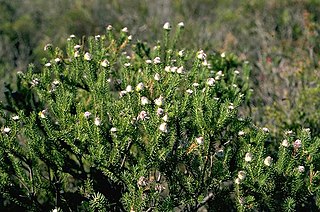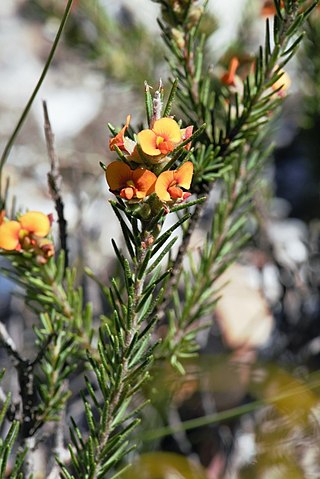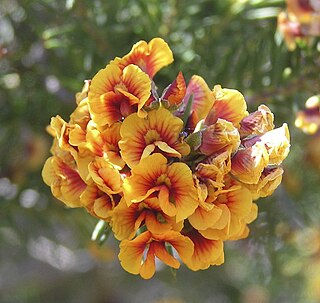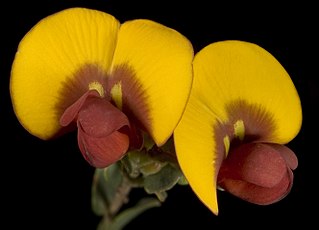
Grevillea preissii is a species of flowering plant in the family Proteaceae and is endemic to the southwest of Western Australia. It is a mounded to spreading or dense, erect shrub, the leaves divided with 5 to 7 linear to more or less cylindrical lobes, and groups of reddish flowers arranged along one side of the flowering rachis.

Grevillea candolleana, commonly known as the Toodyay grevillea, is a species of flowering plant in the family Proteaceae and is endemic to a restricted part of the south-west of Western Australia. It is a shrub with narrow egg-shaped to linear leaves and white to cream-coloured flowers.
Grevillea pinifolia, commonly known as the pine-leaved grevillea, is a species of flowering plant in the family Proteaceae and is endemic to a restricted area in the south-west of Western Australia. It is a low, mounded shrub with linear, more or less cylindrical leaves and red to orange-red flowers.

Petrophile scabriuscula is a species of flowering plant in the family Proteaceae and is endemic to southwestern Western Australia. It is a dense, prickly shrub with sharply-pointed, needle-shaped leaves more or less pressed against the branchlets, and oval heads of hairy, yellow to creamy-yellow flowers.

Dillwynia brunioides, commonly known as sandstone parrot-pea, is a species of flowering plant in the family Fabaceae and is endemic to New South Wales. It is an erect shrub with silky-hairy stems, linear, grooved leaves and yellow flowers with red markings.

Dillwynia pungens is a species of flowering plant in the family Fabaceae and is endemic to the south coast of Western Australia. It is an erect, spindly shrub with cylindrical leaves and yellow flowers with red or orange markings.
Pultenaea aspalathoides is a species of flowering plant in the family Fabaceae and is endemic to the south of Western Australia. It is an erect, spindly shrub with hairy, needle-shaped leaves and yellow flowers.

Pultenaea empetrifolia is a species of flowering plant in the family Fabaceae and is endemic to the south-west of Western Australia. It is a spindly, prostrate or spreading shrub with down-curved, cylindrical, grooved leaves and yellow to orange and red flowers.

Pultenaea ochreata is a species of flowering plant in the family Fabaceae and is endemic to the south-west of Western Australia. It is an erect shrub with egg-shaped leaves with the narrower end towards the base and yellow-orange flowers with red or brown marks.
Pultenaea pinifolia is a species of flowering plant in the family Fabaceae and is endemic to the south-west of Western Australia. It is an erect, slender shrub with pine-like leaves and yellow-orange flowers with orange marks.

Bossiaea pulchella is a species of flowering plant in the family Fabaceae and is endemic to the south-west of Western Australia. It is a slender, erect shrub with egg-shaped leaves, and orange-yellow, purplish brown and dark red flowers.

Gompholobium preissii is a species of flowering plant in the family Fabaceae and is endemic to the south-west of Western Australia. It is an erect shrub with pinnate leaves with five to fifteen leaflets, and yellow, red and orange, pea-like flowers.

Gompholobium shuttleworthii is a species of flowering plant in the pea family Fabaceae and is endemic to the south-west of Western Australia. It is an erect shrub with pinnate leaves with five to nine leaflets, and pink or purple flowers with some darker markings.

Gompholobium villosum is a species of flowering plant in the pea family Fabaceae and is endemic to the south-west of Western Australia. It is a slender, erect shrub with simple, needle-shaped leaves with one or two grooves on the lower surface, and violet, pink or purple flowers.
Bossiaea spinescens is a species of flowering plant in the family Fabaceae and is endemic to the south-west of Western Australia. It is a slender, spreading or compact, spiny shrub with oblong to oval leaves and yellow and reddish-brown, pea-like flowers.
Pultenaea strobilifera is a species of flowering plant in the family Fabaceae and is endemic to the south-west of Western Australia. It is an open to dense, domed or spindly, erect shrub with simple leaves and yellow-orange and salmon pink to bright pink flowers.
Gompholobium viscidulum is a species of flowering plant in the pea family Fabaceae and is endemic to the south-west of Western Australia. It is an erect shrub with pinnate leaves with five to seven leaflets, and yellow flowers.
Daviesia benthamii is a species of flowering plant in the family Fabaceae and is endemic to the west of Western Australia. It is an erect, bushy shrub with scattered, cylindrical, sharply pointed phyllodes, and yellow-orange and reddish-brown flowers.

Daviesia brachyphylla is a species of flowering plant in the family Fabaceae and is endemic to the south-west of Western Australia. It is a spreading to bushy shrub with cylindrical phyllodes with a slightly downcurved point and orange, maroon and red flowers.

Pimelea tinctoria is a species of flowering plant in the family Thymelaeaceae and is endemic to the south-west of Western Australia. It is an erect, spindly shrub with elliptic leaves arranged in opposite pairs, and compact heads of many yellow or yellowish-green flowers usually surrounded by 4 to 7 pairs of egg-shaped to narrowly elliptic yellow and green involucral bracts.













